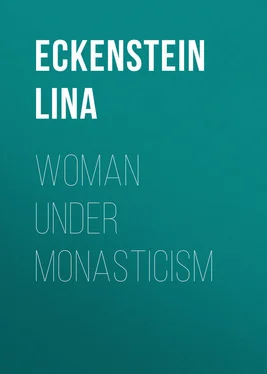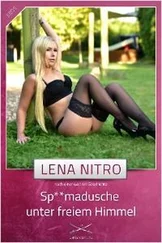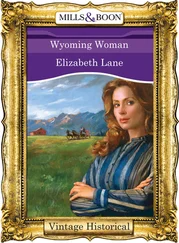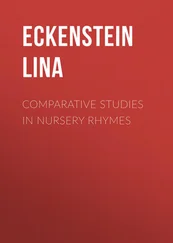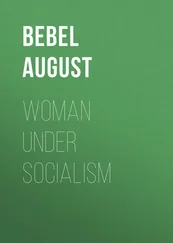Lina Eckenstein - Woman under Monasticism
Здесь есть возможность читать онлайн «Lina Eckenstein - Woman under Monasticism» — ознакомительный отрывок электронной книги совершенно бесплатно, а после прочтения отрывка купить полную версию. В некоторых случаях можно слушать аудио, скачать через торрент в формате fb2 и присутствует краткое содержание. Жанр: История, foreign_antique, foreign_prose, на английском языке. Описание произведения, (предисловие) а так же отзывы посетителей доступны на портале библиотеки ЛибКат.
- Название:Woman under Monasticism
- Автор:
- Жанр:
- Год:неизвестен
- ISBN:нет данных
- Рейтинг книги:4 / 5. Голосов: 1
-
Избранное:Добавить в избранное
- Отзывы:
-
Ваша оценка:
- 80
- 1
- 2
- 3
- 4
- 5
Woman under Monasticism: краткое содержание, описание и аннотация
Предлагаем к чтению аннотацию, описание, краткое содержание или предисловие (зависит от того, что написал сам автор книги «Woman under Monasticism»). Если вы не нашли необходимую информацию о книге — напишите в комментариях, мы постараемся отыскать её.
Woman under Monasticism — читать онлайн ознакомительный отрывок
Ниже представлен текст книги, разбитый по страницам. Система сохранения места последней прочитанной страницы, позволяет с удобством читать онлайн бесплатно книгу «Woman under Monasticism», без необходимости каждый раз заново искать на чём Вы остановились. Поставьте закладку, и сможете в любой момент перейти на страницу, на которой закончили чтение.
Интервал:
Закладка:
It must be granted that the character of the mother-age in some of its bearings is hypothetical, but we can infer many of the social arrangements of the period from surviving customs and usages, and its organisation from the part woman played in tradition and saga, and, as we shall see later, from folk-traditions preserved in the legends of the saints. And further, unless we admit that the social arrangements of the earlier period differed from those of the later, we are at a loss to account for the veneration in which woman was held and for the influence exerted by her as we confront her on the threshold of written history. When once we grasp the essentials of these earlier arrangements, we hold the clue to the existence of types of character and tendencies which otherwise appear anomalous.
For at the time when contact with Christianity brought with it the possibility of monastic settlements, the love of domestic life had not penetrated so deeply, nor were its conditions so uniformly favourable, but that many women were ready to break away from it. Reminiscences of an independence belonging to them in the past, coupled with the desire for leadership, made many women loth to conform to life inside the family as wives and mothers under conditions formulated by men. Tendencies surviving from the earlier period, and still unsubdued, made the advantages of married life weigh light in the balance against a loss of liberty. To conceive the force of these tendencies is to gain an insight into the elements which the convent forthwith absorbs.
In the world outside the convent commanding figures of womankind become fewer with outgoing heathendom, and the part played by women becomes of less and less importance. There is less room left for the Gannas of history or for the Kriemhilds of saga, for powerful natures such as the Visigoth princess Brunihild, queen of the Franks, or Drahomir of Brandenburg, queen in Bohemia, who gratify their passion for influence with a recklessness which strikes terror into the breasts of their contemporaries. As the old chronicler of St Denis remarks, women who are bent on evil do worse evil than men. But in the convent the influence of womankind lasted longer. Spirited nuns and independent-minded abbesses turn to account the possibilities open to them in a way which commands respect and repeatedly secures superstitious reverence in the outside world. The influence and the powers exerted by these women, as we shall see further on, are altogether remarkable, especially during early Christian times. But we also come across frequent instances of lawlessness among the women who band together in the convent, – a lawlessness to which the arrangements of the earlier age likewise supply a clue. For that very love of independence, which led to beneficial results where it was coupled with self-control and consciousness of greater responsibility, tended in the direction of vagrancy and dissoluteness when it was accompanied by distaste for every kind of restraint.
In this connection we must say a few words on the varying status of loose women, since the estimation in which these women were held and the attitude assumed towards them affected monasticism in various particulars. It is true that during early Christian times little heed was taken of them and few objections were raised to their influence, but later distinct efforts were made by various religious orders to prevent women from drifting into a class which, whatever may have been its condition in past times, was felt to be steadily and surely deteriorating.
The distinction of women into so-called respectable and disreputable classes dates from before the introduction of Christianity. It arose as the father-age gained on the mother-age, when appropriated women were more and more absorbed into domesticity, while those women outside, who either resented or escaped subjection, found their position surrounded by increasing difficulties, and aspersion more and more cast on their independence. By accepting the distinction, the teachers of Christianity certainly helped to make it more definite; but for centuries the existence of loose women, so far from being condemned, was hardly discountenanced by them. The revenues which ecclesiastical courts and royal households derived from taxes levied on these women as a class yield proof of this 2 2 Kriegk, G. L., Deutsches Bürgerthum im Mittelalter , 1868, ch. 12-15.
. Certainly efforts were made to set limits to their practices and the disorderly tendencies which in the nature of things became connected with them and with those with whom they habitually consorted. But this was done not so much to restrain them as to protect women of the other class from being confounded with them. Down to the time of the Reformation, the idea that the existence of loose women as a class should be discountenanced does not present itself, for they were a recognised feature of court life and of town life everywhere. Marshalled into bands, they accompanied the king and the army on their most distant expeditions, and stepped to the fore wherever there was question of merrymaking or entertainment. Indeed there is reason to believe, improbable though it may seem at first sight, that women of loose life, as we come across them in the Middle Ages, are successors to a class which had been powerful in the past. They are not altogether depraved and despised characters such as legislation founded on tenets of Roman Law chose to stamp them. For law and custom are often at variance regarding the rights and privileges belonging to them. These rights and privileges they retained in various particulars till the time of the Reformation, which indeed marks a turning point in the attitude taken by society towards women generally.
Different ages have different standards of purity and faithfulness. The loose or unattached women of the past are of many kinds and many types; to apply the term prostitute to them raises a false idea of their position as compared with that of women in other walks of life. If we would deal with them as a class at all, it is only this they have in common, – that they are indifferent to the ties of family, and that the men who associate with them are not by so doing held to incur any responsibility towards them or towards their offspring.
If we bear in mind the part these women have played and the modifications which their status has undergone, it will be seen that the subject is one which nearly affects monasticism. For the convent accepted the dislike women felt to domestic subjection and countenanced them in their refusal to undertake the duties of married life. It offered an escape from the tyranny of the family, but it did so on condition of such a sacrifice of personal independence, as in the outside world more and more involved the loss of good repute. On the face of it, a greater contrast than that between the loose woman and the nun is hard to conceive; and yet they have this in common, that they are both the outcome of the refusal among womankind to accept married relations on the basis of the subjection imposed by the father-age.
In other respects too the earlier heathen period was not without influence on the incoming Christian faith, and helped to determine its conceptions with regard to women. In actual life the sacerdotal privileges, which tribal mothers had appropriated to themselves at the time of the introduction of Christianity, were retained by the priestess; while in the realm of the ideal the reverence in which tribal mothers had been held still lived on in the worship of the tribal mother-divinity. It is under this twofold aspect, as priestess and as tribal mother-goddess, that the power of women was brought face to face with Christianity; the priestess and the mother-goddess were the well-defined types of heathen womanhood with which the early Church was called upon to deal.
Читать дальшеИнтервал:
Закладка:
Похожие книги на «Woman under Monasticism»
Представляем Вашему вниманию похожие книги на «Woman under Monasticism» списком для выбора. Мы отобрали схожую по названию и смыслу литературу в надежде предоставить читателям больше вариантов отыскать новые, интересные, ещё непрочитанные произведения.
Обсуждение, отзывы о книге «Woman under Monasticism» и просто собственные мнения читателей. Оставьте ваши комментарии, напишите, что Вы думаете о произведении, его смысле или главных героях. Укажите что конкретно понравилось, а что нет, и почему Вы так считаете.
